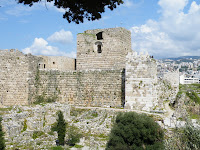Lebanon - Day 3: Dog River, Harissa and Byblos.
 |
| Byblos Souq - Lebanon |
After the impressive ruins of Baalbeck our visit to Dog River, Harissa and Byblos could have been anti-climatic but, like so much of Lebanon, this was yet another great day.
 |
| Pigeon Rocks - Beirut |
We started the day with a tour of Beirut from the Pigeon Rocks, which are the icons for the city, to the central square- Place d'Etoile and the newly rebuilt area of the city. Here we visited the Greek Orthodox church of St George, the Maronite Church with its tall bell tower standing beside the new Mohammed Al-Amin mosque. All of the churches are close to the "Green Line" that marked the killing zone and boundary between the warring Christian and Muslim factions during the civil war (1975-96) which leads down past the tomb of the assissinated prime minister, Rafiq Hariri, to the Martyrs' Square and the much shot up statue of the Lebanese martyrs executed there by the Turks in 1916.



 |
| The Martyrs' statue |
The Dog River, Nahr el Kalb, has been a natural barrier to the different invaders entering the country. The Egyptians, in the 14th century, had declared the river to be the boundary between the Egyptian empire and the Hittites while, in later centuries, the river gorge was the point where different conquerers left their marks, carving monuments and stele along the gorge to commemorate their presence and victories. There are markers left by Rameses II, Nebuchadnezzar, Marcus Aurelius and modern French, Australian and British forces in the 20th century.
 |
| Stele marking the Roman invasion |
 |
| Roman Bridge on Dog River |
A narrow Roman bridge a little way up the gorge is the reminder of the only way invaders had managed to cross the river and continue their invasions.
 |
| The Lady of Lebanon |
Across the river the city of Jouneih marks the point to visit Harissa and the statue of the Lady of Lebanon and the Maronite cathedral of Lebanon which towers over the city. We opted not to ride the cable car up the 650 metre hillside and drove up the hill to the summit. After enjoying the view over the bay we headed off to explore Byblos.

Byblos was once a Crusader harbour and is now a quiet fishing harbour. Historically the city is one of the oldest continuously inhabited cities in the world. Apparently it has been inhabited for over 7 millenia and has been the centre for pottery and trade since Phoenecian times and gave the world the alphabetic script we use, in varying forms, even now.

Like Baalbeck, Byblos has seen its far share of invaders - Greek, Roman, Byzantine, arab, Crusaders and Ottoman - and is dominated by the Crusader Castle built in the 12th century using stones stripped from the earlier Roman and Byzantine buildings that dot the site.

Around the castle the ruins of a Roman theatre, Phoenecian tombs and the remains of neolithic and chalcolithic housing provide ample grounds for speculation about the history of the area.
The Byblos souq is yet another place which would reward the avid bargain hunter with its numerous shops including the interesting Memoire du Temps which specialises in fossils of ancient fish preserved in the limestone of the local hillsides.
 |
| Temple to Jupiter - Byblos |


We lunched at a local sea food restaurant, Ode Mer, where we enjoyed a magnificent meal that left us feeling full and extremely well satisfied before spending the rest of the afternoon exploring the old town of Jouneih.
No comments:
Post a Comment